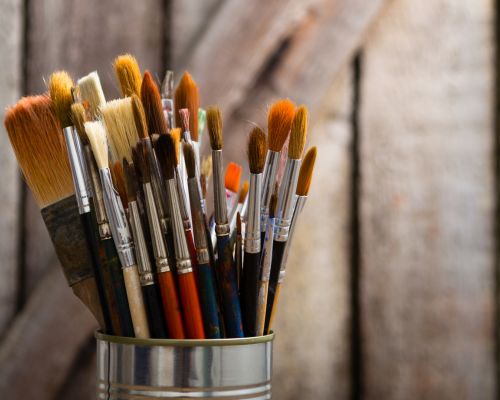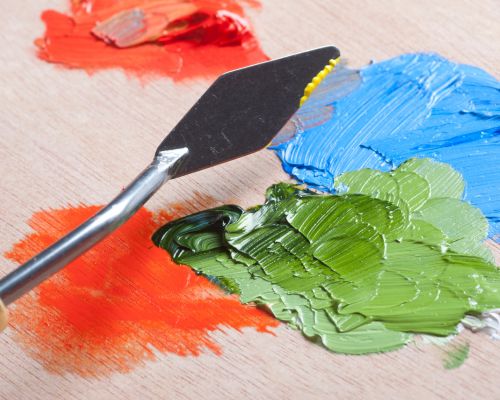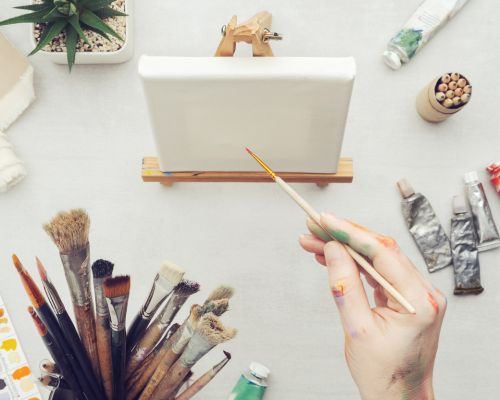How To Use Acrylic Paint: A Step-By-Step Guide For Beginners
If you want to learn how to use acrylic paint, you’re at the right place!
Acrylic paint is a fantastic medium that will allow you to easily create paintings in any style imaginable. More importantly, working with acrylic paint is perfect for beginners since it’s more than affordable.
Most professional artists use acrylic paint while creating their artworks. Before you can do the same, you’ll have to learn the best ways to use acrylic paint.
In this article, you’ll see how to efficiently use paint when creating your acrylic paintings. Let’s get started, shall we?
What Are Acrylic Paints?

Assuming most of you reading are first-time or aspiring artists, I want to cover the basics of using acrylic paint. And that entails explaining what acrylic paint is:
To sum up, acrylic paint is water-based and fast-drying medium. It’s made of pigment suspended in acrylic polymer emulsion, defoamers, silicone oils, or metal soaps. Feel free to visit Wikipedia if you want to read everything there is to know about acrylic paint.
While most acrylic paints are water-based, you should know they’ll become water-resistant once they dry. Subsequently, your painting might look like an oil or watercolor artwork, depending on how much your acrylic paint is diluted with water.
Acrylic Painting For Beginners – What Materials You’ll Need?
It goes without saying that you can’t start your first acrylic painting without the materials necessary to create it.
Here are all the essential art supplies you must have to paint acrylic artwork:
Acrylic Paint
Generally, there are two types of acrylic paint to choose from – fluid and heavy body.
As you probably already know, the fluid acrylic paint is thinner than the heavy body one – that can be a good thing, depending on the idea behind the painting you want to create.
Now, heavy-body acrylic paint is a medium with higher viscosity, which means such paint will be perfect if you’re aiming for a thicker consistency.
I can’t tell you which acrylic paint you should use – the choice you’ll make depends on the style of artwork you have in mind.
For instance, if you imagine a painting with colors that easily blend, you might want to use fluid acrylic paint. But if you’re a fan of acrylic techniques like strokes or impasto, heavy-body acrylic paint will do the trick.
What about the colors? After all, there are so many of them!
Don’t let the number of available acrylic colors intimidate you – there is no need to buy all of them. I suggest starting with 5-7 colors you can mix to come up with different ones.
With that said, at least two of the colors you’ll get must be primary. Personally, my painting journey began with nothing more than a tube of white, black, red, blue, and yellow colors.
Paint Brushes

By all means, you won’t be able to paint your dream acrylic painting with the appropriate acrylic brushes.
In my experience, one round and one flat brush are enough to begin the painting process – you can always expand your brush collection later.
Painting Surface
Have you given any thought about the type of surface you would like to paint on? If you haven’t, now is the time:
Painters can create artwork on almost all kinds of surfaces – canvas, canvas pads, canvas boards, thick paper, and even wood panels.
Of course, the most popular choice of surface for acrylic painting is canvas since it’s pretty affordable.
I highly recommend getting an easel – it will keep your painting surface steady while working (sitting or standing).
Palette
A palette is a helpful tool that will allow you to easily mix your colors. Get a reusable one you can wash after each painting process.
Currently, paper, plastic, glass, and wooden palettes are available. But I would discourage you from getting a paper one since the paint will constantly stick to it.
Palettes are not expensive, so you can use a new one for each painting if you don’t like the idea of washing reusable ones.
Palette Knife

Honestly, I can’t imagine doing a single painting without using my palette knife – the tool is invaluable, to say the least.
There are so many ways to use a palette knife while painting – you can mix your paints with the knife, apply them on the painting surface, and even remove them when necessary.
Take advantage of all the painting techniques a palette knife will allow you to implement, such as straight lines, shapes, thick textures, etc.
Water, Scrap Paper, And Towels
Can you imagine creating a painting without water nearby? I can’t, and you shouldn’t be able to either!
Washing your brushes while working is an essential part of the painting process. And so is having scrap paper where you can mix colors before they find a place on the artwork.
Towels are a must too – you’ll need them to clean your fingers from the paint that will undoubtfully get there while you’re painting.
How To Use Acrylic Paint On Paper

As you already know, acrylic paint is water-based, so you can use it similarly to watercolor.
Feel free to use acrylic paint on paper as long as that paper is thick and of excellent quality.
If you decide to paint with acrylics on paper, keep in mind that you can’t reactivate the paint once it’s dry like you can with watercolors.
How To Use Acrylic Paint On Canvas

Quite frankly, there are many ways to use acrylic paint on canvas – every artist has its own process.
With that said, it’s important to remember that each layer of paint you’ll place on the canvas has to be completely dry before you add another one.
Acrylic Paint Tips And Tricks
Wet Your Brush Before Your Start Painting
OK, wetting your brush before you begin to paint is not a set-in-stone rule. Still, you should do it if you want your paint to move smoothly while you’re working.
Don’t Allow Your Palette To Get Dry
Again, acrylic paint dries super quickly, so it’s not a good idea to create your palette before you’re ready to start painting.
What if you need to take a break? Well, I suggest covering your palette (plastic will do) to keep it wet until you can resume the painting process.
Also, don’t leave the caps off your acrylic paints if you want to keep using them for as long as possible.
Never Mix Acrylics And Oil
I know – we all have seen paintings that have been created with both oil and acrylic paints. I don’t think beginner artists should do that, though:
Oil paints (or anything oil-based) doesn’t mix well with acrylics. Mixing these two paints will probably result in something you’ll mostly likely not enjoy looking at.
Another thing I don’t recommend is overmixing your paints – you don’t want to see any bubbles on your painting surface!
Don’t Be Afraid To Blend Colors
Blending colors is a common painting technique all artists use at a certain point, and you should too:
Why use acrylic paint straight out of the bottle when you can mix colors and create something outstanding?
Mixing colors will allow you to create a painting that is a unique piece of art – don’t you want that?
Use Different Brushes
Personally, I have one brush that is a favorite of mine – I use it almost constantly. But that doesn’t mean that brush is the only one I work with during the painting process.
Mix it up a little, would you?
Flat and round brushes deliver different results when creating strokes, textures, and shapes. Test which of your brushes does a better job when you want to create a specific detail of your painting.
Pro Tip:
Placing too much paint on your brush is the worst thing you can do as an artist – it will extend the drying time and make it harder to control the creative process.
Remove All The Paint Of Your Brushes
Cleaning your brushes well before you begin each painting is something I shouldn’t even have to mention:
Once acrylic paint dries on a brush, it’s not that easy to remove it. So, don’t forget to clean your brushes each time you conclude an artwork.
It’s OK To Make Mistakes
The more you paint, the more mistakes you’ll make, and that’s OK:
Who knows, maybe what you consider a mistake will turn out to be one of your best artworks ever!
Final Say
Do you know everything there is to know about how to use acrylic paint?
I sure hope so.
But if you don’t, you can ask me any questions you have on this topic.
Write them down in the comments section, and I’ll provide answers as soon as possible.
Hello, thank you for this article. I have never used acrylic paint but in my research I’ve seen that you might need a pouring medium and a silicone. Is this necessary? Thank you
It is not necessary, Jerry, but you can use a pouring medium if that’s what you want to do!